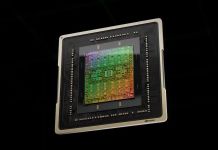GeForce 8800GTX and GeForce 8800GTS will be the names of the two first G80-based graphics cards on the market and behind the names are tons of exciting, new technology. At DailyTech they’ve had the chance of looking the first production samples of GeForce 8800 and the information they now share is truly a real kick. First of all the cards are both large and consume tons of power. NVIDIA will most likely recommend a 450W power supply for a system with GeForce 8800GTX and if you’re going for SLI you should have 800W or more. Luckily the previous information about the card being 28 cm long was false, according to DailyTech the cards have a more humane length of only 22 cm (8.7 inches).
The flagship will be 8800GTX and this card will have a core clock frequency of 575MHz, which will be paired with 768MB GDDR3 memory. The memory will in turn be clocked at 900MHz (1.8GHz) and will with a 384-bit memory bus be able to offer a memory bandwidth of a whopping 86GB/s. The most interesting bit with the card and the G80 circuits architecture is that it in fact does have unified shaders processors. This means that the shader processors of the circuit can handle both pixel, vertex and geometry calculations. This matches the previous information we received. There are 128 shader processors that will be working at 1350MHz, which explains that high clock frequencies we earlier told you about.
This results in a theoretic texture fill-rate at about 38.4 billion pixels per second, which you can compare to Radeon X1950 XTX that has a fill-rate of 10.4 billion pixels per second.
GeForce 8800GTS has a similar layout but has to settle with a core frequency of 500MHz, 640MB GDDR3 memory clocked at 900MHz and memory bus at 320-bit. The number of shader processors have also been reduced, more precise to 96 and are clocked at 1200MHz.
Both card will use a dual-slot cooling, but we don’t know if it is a hybrid or not. In the end, G80 looks mighty impressive and the launch will be in about a month, the second week of November. From what it seems the cards will be in store then, which bodes well for NVIDIA but could become a real burdon for ATI and R600.

















